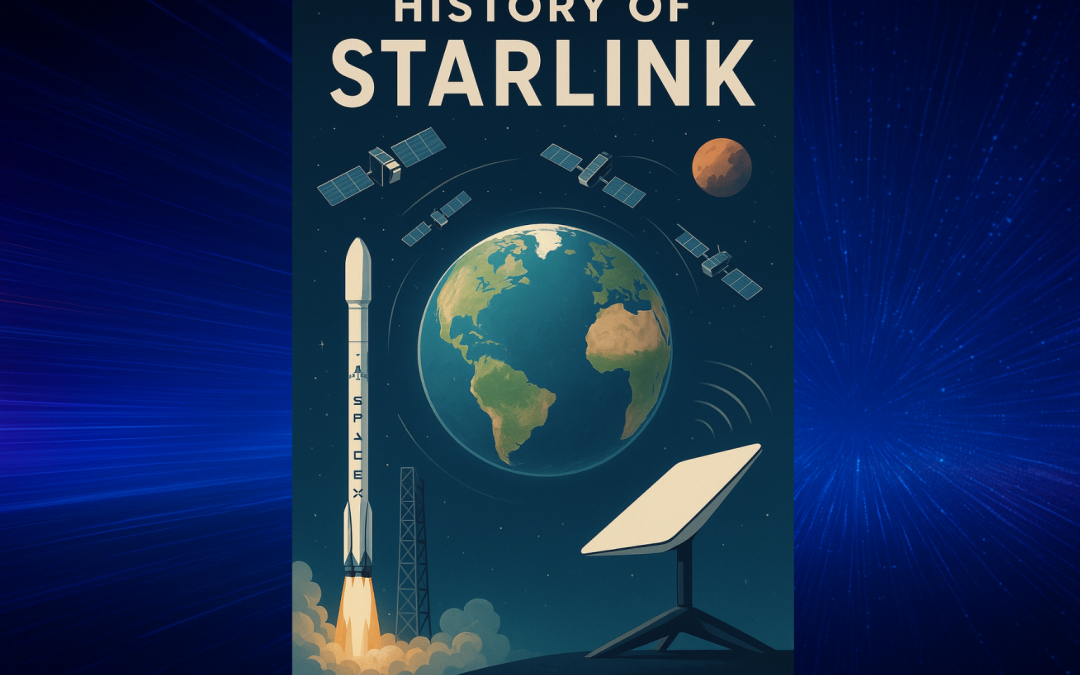History of Starlink — who started it and when
Discover the full history of Starlink — who created it, when the project began, and how SpaceX built the world’s largest low-Earth-orbit satellite internet constellation. Timeline, key milestones, and why Starlink matters for global connectivity.
What is Starlink and why its history matters
Starlink is SpaceX’s satellite-internet constellation designed to deliver high-speed, low-latency broadband from low Earth orbit (LEO) to people and businesses worldwide. The project grew from a technical idea into a global service used in remote communities, maritime and aviation sectors, disaster response, and even national security applications. Understanding when Starlink started and who launched it explains not only how the technology evolved but also why it changed the economics of global internet access.
Origins: the idea and the announcement (2014–2015)
Starlink’s origins trace back to SpaceX leadership deciding to solve two big problems at once: create a new revenue stream for the company, and deliver affordable broadband to underserved parts of the world. The public phase of that idea began in January 2015, when SpaceX opened satellite development operations in Redmond, Washington and CEO Elon Musk publicly discussed plans for a massive LEO constellation to provide broadband service. The concept was ambitious: thousands of small, mass-produced satellites working together to create continuous global coverage.
From a technical point of view, the project built on decades of research into LEO constellations (from Iridium and Globalstar to later proposals like Teledesic) but took advantage of dramatically reduced launch costs, SpaceX’s own rockets, and modern phased-array antennas and networking electronics. These factors made a large, continuously upgraded constellation economically plausible in a way earlier projects were not.
Who started Starlink? — the people and the company
Starlink was started by SpaceX, the private aerospace company founded by Elon Musk. While a large team of engineers and program managers designed, built, and fielded the system, Musk is the public founder and primary driver of the project’s strategy and financing. SpaceX assembled dedicated satellite teams in the mid-2010s, growing from an initial small R&D group into large manufacturing facilities focused on mass production. Key early personnel included SpaceX engineering leads and satellite specialists recruited to the Redmond facilities, though the company rarely credits single authors — Starlink was developed as an internal SpaceX program.
Development and regulatory steps (2016–2018)
Before large-scale launches could begin, SpaceX needed regulatory approval and had to finalize system design details. In 2016–2017 SpaceX applied to and received Federal Communications Commission (FCC) clearance to operate a non-geostationary satellite system using Ku and Ka bands. The FCC license set deployment milestones — notably a requirement to place a significant portion of the constellation in orbit within a set timeframe — and pushed SpaceX toward rapid prototyping and mass production. The regulatory filings also required de-orbiting plans and other mitigation measures to address space-debris concerns.
In parallel, the engineering team moved from prototypes to a production design, refining satellite networking, user terminals, and ground infrastructure. SpaceX invested in factories and hiring to ramp up output, because the plan called for launching dozens to hundreds of satellites per year rather than one or two at a time.
First flights: prototypes and the first operational batch (2018–2019)
Starlink’s earliest flight tests began with two prototype satellites launched in February 2018 to validate core technologies such as phased-array radio links and satellite control systems. These missions were followed by the first “production-design” batch of 60 satellites launched on May 24, 2019 aboard a Falcon 9 rocket. That May 2019 flight is commonly treated as the start of the operational Starlink constellation, since those 60 satellites used the production hardware intended for the full network.
After proving basic operations, SpaceX rapidly increased launch cadence — a capability unique to the company thanks to Falcon 9 reusability and internal launch manifest control. Launch cadence allowed SpaceX to scale the constellation, growing from hundreds to thousands of satellites within a few years.
Commercial service rollout (2020–2021)
By 2020 SpaceX began private and limited public beta tests. The company invited users to trial service, initially charging modest fees to test billing and provisioning systems while still improving satellite performance. In mid-2020 Starlink opened limited beta access in parts of the United States, and service gradually expanded internationally. By 2021 Starlink had an established commercial offering and tens of thousands of early adopters in rural areas, maritime users, and specialty markets.
The rollout focused on three parallel challenges: improving bandwidth and latency by deploying more satellites and better inter-satellite links; scaling production of user terminals and simplified antennas; and negotiating regulatory approvals and partnerships in different countries.
Rapid expansion and milestones (2022–2025)
Starlink’s growth after commercial launch was remarkable. SpaceX kept increasing satellite production — at times reporting multiple satellites produced per day — and maintained one of the busiest launch manifests in the world. By 2024–2025 the constellation had reached many thousands of satellites launched, enabling global coverage and new service tiers (maritime, aviation, business) and partnerships with telecoms and governments. Major milestones included approval processes for second-generation satellites (Gen2), trials with mobile carriers for satellite-to-cell services, and contracts for critical infrastructure support in remote and crisis settings.
SpaceX’s decision to use its Falcon 9 — and later plans to migrate larger payloads to Starship — directly shaped the pace of deployment: having a low-cost, frequently launched vehicle enabled the ambitious timeline SpaceX set for Starlink’s global buildout.
Controversies and challenges in Starlink’s history
No major technological program is without controversy. Starlink has faced concerns and criticism on several fronts:
-
Space debris and astronomy: Large constellations raise issues for orbital congestion and visible-sky brightness that affect ground-based astronomy. SpaceX implemented mitigation measures, such as darkening satellites and planning de-orbit strategies, but concerns remain.
-
Regulatory and political friction: Starlink’s operations intersect with national regulators and political decisions — for example, licensing disputes and occasional device seizures in certain countries. That tension sometimes created headlines and regulatory scrutiny.
-
Business economics: Scaling to thousands of satellites required enormous capital and complex manufacturing logistics; public reporting shows Starlink’s revenue trajectory took years to approach profitability, reflecting the heavy upfront investment required.
These challenges shaped how SpaceX adjusted technical, operational, and commercial strategies over time.
Why Starlink’s start matters today
Knowing who started Starlink (SpaceX and Elon Musk) and when the program moved from idea to operations (public announcement/Redmond facility in 2015, first prototypes 2018, first operational batch 2019) helps explain several broader trends:
-
Lowered barriers to large constellations: SpaceX’s vertically integrated model—design, manufacture, and launch in-house—showed how to scale an LEO internet system in a commercially viable way.
-
New market dynamics: Starlink’s deployment prompted legacy satellite operators, governments, and competitors (like Amazon’s Project Kuiper) to accelerate their own plans, changing the future of global broadband infrastructure.
-
Real-world impact: From connecting remote hospitals to keeping emergency communications online during disasters or conflicts, Starlink’s network has had immediate practical implications, illustrating how infrastructure choices affect society.
Quick timeline (concise)
-
2015 — SpaceX publicly announces satellite internet plans and opens Redmond development facility.
-
2016–2017 — Regulatory filings and FCC license granted for an NGSO system.
-
Feb 2018 — Two prototype satellites launched.
-
May 24, 2019 — First 60 “production-design” Starlink satellites launched (key operational milestone).
-
2020–2021 — Beta testing and commercial rollout begin; rapid scale-up in launches.
-
2022–2025 — Global expansion, new service tiers, and thousands of satellites launched.
Starlink’s legacy and the road ahead
Starlink began as a bold internal project at SpaceX, publicly announced in 2015 and driven by Elon Musk’s vision to both connect the world and fund future space ambitions. The program moved from concept to prototypes in 2018 and to operational deployment in 2019, before expanding into a commercial global service. Its history is an example of rapid innovation enabled by integrated design and low-cost launch capability, but it also illustrates the tradeoffs and responsibilities that come with building infrastructure in space. As Starlink evolves — with Gen2 satellites, Starship-enabled launches, and new regulatory chapters — its early history will remain a key part of the story of 21st-century connectivity.

